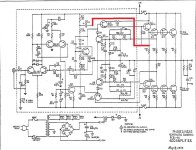I don't think there is any issue to saturate Q9.The bootstrap will saturate Q9 when clipping. Clamping diodes are needed.
How?If a driver transistor saturates, both output transistors will be on.
It only saturates on up side, it does no harm.
The only issue is how fast it can come out of saturation. It won’t be so slow (even with a TIP41) that it would result in cross conduction, but will result in high order distortion. Higher order distortion products tend to be more audible than low order ones. It will make clipping more obvious, when it happens. It’s one reason I really like the EF3. The predriver can be made very small to come out of saturation quick, since it doesn’t have to handle currents upwards of an amp when the outputs start running out of beta.
R23 is the speed up mechanism for getting Q10 out of saturation quickly. Without the resistor it is slower. And the unusual connection (to the emitter of the driver, not the speaker out) is because of the intended fully class B operation. With factory bias, if the cap is connected to output the crossover distortion is intolerable. Depending on output transistor choice, class AB often results in instability. But this connection has other problems too. If the cap gets leaky the amp will snap to the rail. Not good when there is no protection relay!!!!!!! I automatically change this cap out with a new 100uf/100V Nichicon any time I’m inside one. When doing a complementary conversion with MJ15024/5, it gets re-routed to the output, and I bias at 10 mA or more per output device.
You will also notice that R18 is much smaller than R17 so that the bootstrap voltage is limited, not 50% of the rail as is common.
One doesn’t really need half the rail, but doing so results in the highest effective R value (both R’s equal), resulting in the lowest pole frequency for a given cap. With the high values in the PL you can sort of waste it a bit. In the days of EF1, using two 180 ohm was a big deal.
Found a very interesting thread here lots of useful info, I may have to try the protection diode mentioned.
When I read this thread I wonder about one issue.
Hugh, and Rod are two persons here which are keen on using bootstrap for driving the output transistors.
I wonder what are the pros and cons?
Pros: More power with given design, more peak drive voltage, less parts, simplier power supply for the drive circuits.
Cons: Start-up thumps, poor bass performance(?), poor clipping characteristics(?)
Is the major reason to use bootstrap to save parts (=costs)?
Are there any sonic properties involved?
Hugh, and Rod are two persons here which are keen on using bootstrap for driving the output transistors.
I wonder what are the pros and cons?
Pros: More power with given design, more peak drive voltage, less parts, simplier power supply for the drive circuits.
Cons: Start-up thumps, poor bass performance(?), poor clipping characteristics(?)
Is the major reason to use bootstrap to save parts (=costs)?
Are there any sonic properties involved?
- peranders
- Replies: 125
- Forum: Solid State
Similar threads may have appeared here touching the subject of CCS versus Bootstrap configurations and I have simulated and build two identical amplifiers one using a CCS and the other a Bootstrap.
Interestingly enough the amplifiers overall performance is very similar, identical output, band width and overall THD.
However they sound remarkably different the amplifier using a bootstrap has a warmer and friendlier sound while the one with CCS has a more clinical and harsh sound.
Following is the amplifier with CCS, its band width and harmonic distortion at 1kHz, 10 kHz and 100 kHz.
Then...
Interestingly enough the amplifiers overall performance is very similar, identical output, band width and overall THD.
However they sound remarkably different the amplifier using a bootstrap has a warmer and friendlier sound while the one with CCS has a more clinical and harsh sound.
Following is the amplifier with CCS, its band width and harmonic distortion at 1kHz, 10 kHz and 100 kHz.
Then...
- U102324
- Replies: 84
- Forum: Solid State
- Home
- Amplifiers
- Solid State
- Unusual bootstrap standard EF
